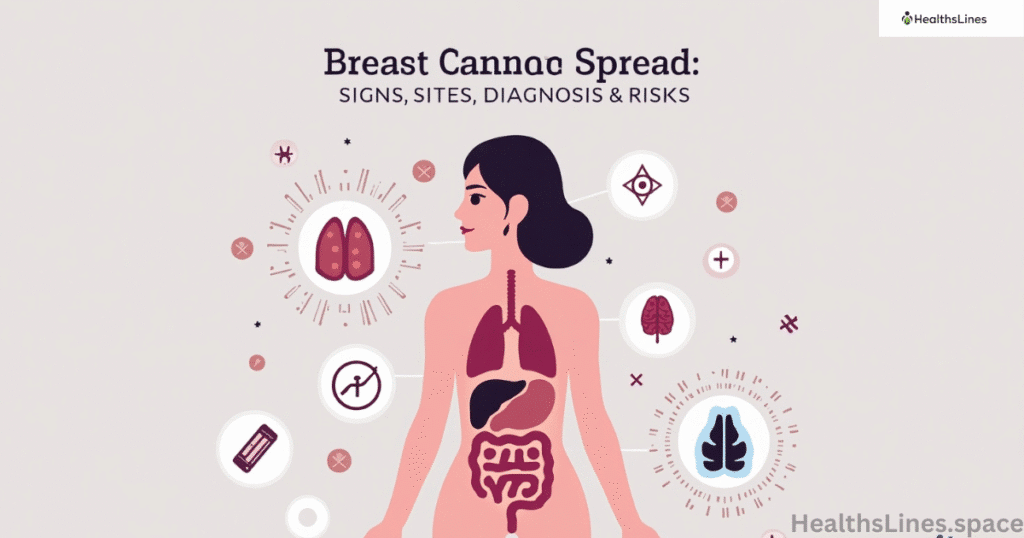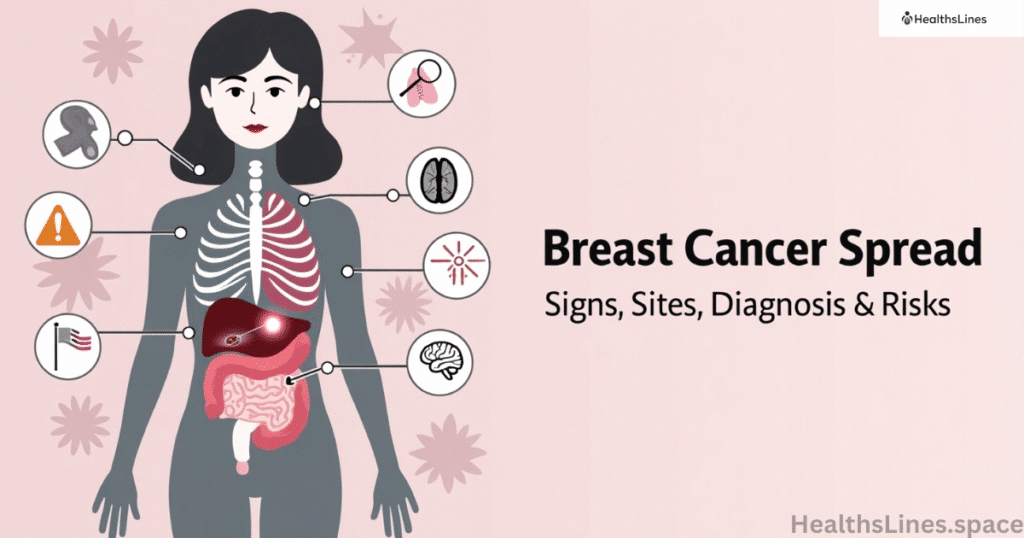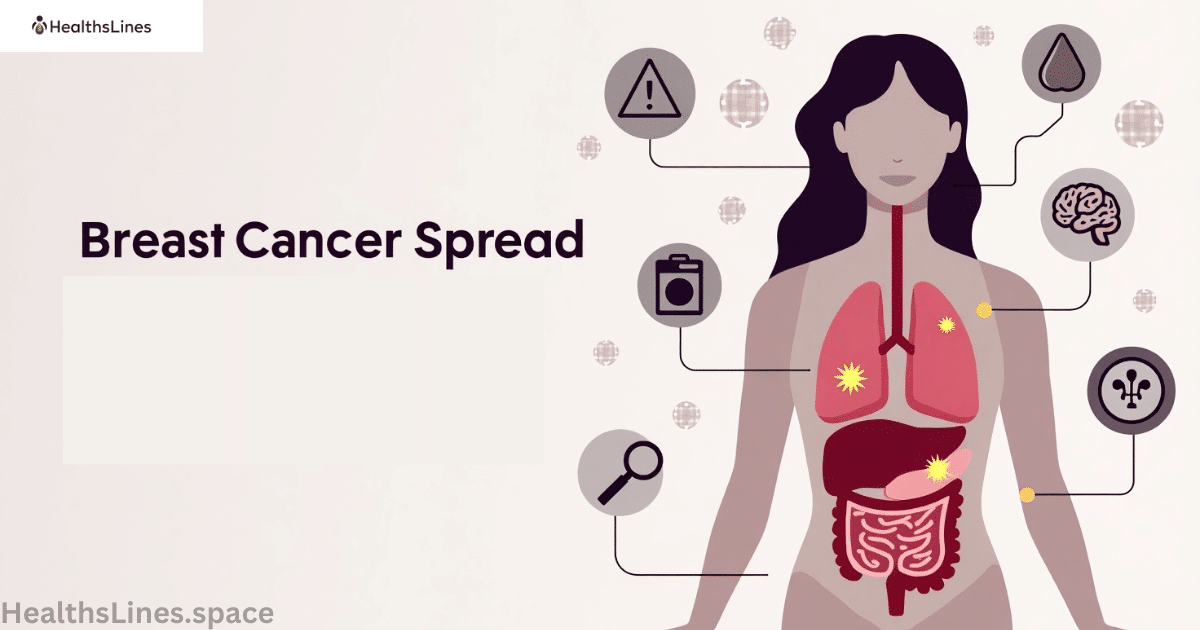Breast cancer metastasis happens when cancer cells move from the breast to other parts of the body. This stage is called stage 4 breast cancer or metastatic breast cancer. It is more serious than earlier stages because the disease spreads beyond the breast and lymph nodes Breast Cancer Spread. Understanding where breast cancer spreads, its symptoms, and how it is diagnosed can help patients and families make informed decisions.
Doctors call the process of spreading “metastasis.” Cancer cells travel through the blood or lymphatic system and settle in new organs. Once there, they start growing and form tumors. The most common places for breast cancer spread are the bones, lungs, liver, and brain. Sometimes, it can also spread to skin, ovaries, or other soft tissues. Each location shows different signs, so knowing the symptoms helps with early detection.
Where Breast Cancer Commonly Spreads
How breast cancer spreads depends on how aggressive the cancer is and its type. Cancer cells break off from the original tumor and move through the bloodstream or lymph system. They attach to other tissues and start forming tumors. Doctors use imaging tests like CT scans, MRI scans, PET scans, and bone scans to check for spread. Blood tests and tumor markers such as CA 15-3 and CEA also help find metastasis.
Here’s a table showing the most common sites of breast cancer metastasis and symptoms:
| Location | Common Symptoms |
| Bones | Bone pain, fractures, weakness |
| Lungs | Shortness of breath, cough, chest pain |
| Liver | Jaundice, swelling, appetite loss |
| Brain | Headaches, dizziness, confusion |
Bone Metastasis Breast Cancer
Bone metastasis breast cancer is the most common form of metastatic spread. It usually affects the spine, ribs, pelvis, and long bones in the arms and legs. Patients may feel deep bone pain that worsens at night. There may also be swelling and risk of fractures. Sometimes, high calcium levels in the blood can cause confusion, fatigue, and stomach pain. Doctors use bone scans and MRI scans to detect bone metastases. Bone-strengthening medications like bisphosphonates and pain relievers are used to manage symptoms.
Lung Metastasis Breast Cancer
Lung metastasis breast cancer can develop without any symptoms at first. Over time, patients may feel shortness of breath, chronic cough, and chest pain. These symptoms can feel like a lung infection, so they are often misdiagnosed. As tumors grow, breathing becomes harder. A CT scan or PET scan shows cancer cells in the lungs. Treatments like chemotherapy, targeted therapy, and radiation therapy help shrink the tumors and improve breathing.
Liver Metastasis Breast Cancer
In liver metastasis breast cancer, symptoms may not show up early. When they do, they can include appetite loss, nausea, swelling in the belly, and jaundice. The liver may feel enlarged, and blood tests can show abnormal liver function. This kind of spread is harder to detect without imaging. A biopsy may be needed to confirm the diagnosis. Treatments involve chemotherapy, immunotherapy, or hormone therapy, depending on the cancer’s features like HER2-positive breast cancer or triple-negative breast cancer.
Brain Metastasis Breast Cancer
Brain metastasis breast cancer is less common but very serious. Cancer cells cross the blood-brain barrier and form tumors in the brain. Symptoms include headaches and memory loss, vision changes, behavior changes, dizziness, and seizures. These changes may be sudden and confusing. An MRI scan is often used to detect brain lesions. Doctors may prescribe steroids for brain swelling, radiation therapy, and medications that cross the blood-brain barrier to treat it.
Other Sites Breast Cancer Can Spread To
While bones, lungs, liver, and brain are the major sites, breast cancer spread can also happen in the ovaries, skin, and soft tissue. These are less common but important to monitor. Skin changes, nodules, or unexplained swelling in the body could be signs. These types of spread are usually found during follow-up scans or when patients report unusual symptoms. Regular screening and open communication with your oncologist are vital.
Recognizing the Signs of Metastatic Spread

Signs of metastatic breast cancer differ depending on where it spreads. Still, some general symptoms can raise concern. These include fatigue, weight loss, ongoing pain, and appetite loss. When cancer spreads to organs like the brain or liver, symptoms may appear quickly and worsen fast. This is why paying attention to your body and knowing breast cancer symptoms by location is critical.
In many cases, signs may seem like unrelated problems. Persistent pain in bones, shortness of breath, jaundice, or sudden memory issues should not be ignored. Cancer patients in remission must continue regular check-ups because cancer recurrence risk factors increase after treatment. These include the original tumor size, lymph node involvement, and cancer type such as HER2-positive or triple-negative breast cancer.
Subtle Clues Your Body May Give You
Often, early signs of cancer spread are easy to miss. A slight cough, mild dizziness, or a small change in appetite might seem normal. But when these signs last for days or worsen, they could indicate metastasis. Other clues like swelling or bloating, sudden vision changes, or changes in mood should be discussed with your doctor. Living with metastatic breast cancer means staying alert to body changes and knowing when to seek help.
How Doctors Diagnose Metastatic Breast Cancer
Diagnosing metastatic breast cancer is a step-by-step process. When patients report new symptoms or have abnormal blood tests, doctors use imaging tools to find out if cancer has spread. These tools include CT scans, PET scans, MRI scans, and bone scans. Blood tests that look for tumor markers like CA 15-3 and CEA help guide diagnosis. A biopsy confirms the presence of cancer cells in a new location.
Doctors also test for cancer biomarkers such as hormone receptor status (ER/PR) and HER2 status. These details help decide which metastatic cancer treatment will work best. Some patients may also take an Oncotype DX test to predict how likely the cancer is to come back. Accurate diagnosis is essential for creating a custom treatment plan and improving outcomes.
The Role of Biomarkers in Diagnosis
Cancer biomarkers are key to understanding what kind of cancer a patient has. HER2-positive, ER/PR-positive, and triple-negative breast cancer respond to different treatments. Doctors use this information to choose between chemotherapy, hormone therapy, or targeted therapy. Biomarker testing can also help patients qualify for cancer clinical trials. The goal is to treat cancer as effectively as possible with the fewest side effects.
Can You Reduce the Risk of Metastasis?
While not all risks can be removed, patients can lower the chance of breast cancer metastasis through lifestyle choices and medical care. Cancer recurrence risk factors include not only the biology of the tumor but also behaviors like smoking, drinking, and obesity. Making changes in daily habits helps improve survival chances. It also supports overall health during and after treatment.
Doctors often recommend healthy habits for cancer survivors. These include a nutrient-rich diet, regular physical activity, and stress reduction. Eating vegetables, fruits, lean proteins, and healthy fats supports healing. Limiting alcohol helps control estrogen levels, which is important for hormone-sensitive cancers. Exercise and cancer prevention go hand in hand, as staying active boosts immunity and lowers inflammation.
Lifestyle Factors That Help
Living well after cancer means making smart choices. Quitting smoking, staying at a healthy weight, and keeping up with check-ups are all part of reducing cancer and obesity risks. Patients often find strength in joining support groups for breast cancer, practicing stress management, and trying complementary cancer therapies like yoga or meditation. These actions do not cure cancer but they improve quality of life.
What Happens After Diagnosis?
After receiving a breast cancer diagnosis that includes metastasis, patients need a treatment plan. Doctors combine different types of therapy based on the cancer’s location and type. Options include chemotherapy, radiation therapy, hormone therapy, immunotherapy, and targeted therapy. In some cases, pain management for cancer and palliative care are necessary to ease symptoms and improve comfort.
Choosing the right treatment depends on many factors: the organs involved, past treatments, and overall health. Some patients may join cancer clinical trials to try new drugs. Others might focus on keeping cancer under control and reducing symptoms. The goal is to extend life and maintain good quality of life, even with late-stage breast cancer.
Living with Metastatic Breast Cancer

Living with metastatic breast cancer means adjusting to a new normal, both physically and emotionally. Since this is stage 4 breast cancer, it requires ongoing treatment and close monitoring. Even though it’s not curable, many people live for years with the disease while managing their symptoms and staying active in their daily lives. Treatment goals often focus on slowing cancer growth, relieving symptoms, and helping you feel as good as possible for as long as possible Breast Cancer Spread. Pain management, controlling fatigue, and addressing emotional challenges are all important parts of care.
Staying connected to a medical team is key. Regular visits allow doctors to track how well treatments are working and make changes when needed. Many patients receive hormone therapy, targeted therapy, or chemotherapy depending on their hormone receptor status, HER2 status, and overall health. Palliative care services are also available to improve comfort and manage symptoms like persistent pain, appetite loss, and fatigue. Some treatments, like bone-strengthening medications or steroids for brain swelling, help reduce complications from bone metastasis or brain metastasis.
Support beyond medical care also matters. Many people benefit from support groups for breast cancer, where they can talk to others who understand what they’re going through. Others turn to complementary cancer therapies such as yoga, meditation, or art therapy for stress relief. Maintaining a healthy lifestyle—eating well, staying active, and finding emotional balance—can make a big difference. Living with metastatic cancer is not easy, but with the right tools and support, many people continue to live meaningful and fulfilling lives.
Conclusion
Breast cancer metastasis is serious, but knowing the facts helps people face it with strength. Cancer can spread to bones, lungs, liver, brain, and more. Each site brings different symptoms, and early detection is key. Tests like PET scans, MRI scans, biopsies, and tumor marker analysis help doctors make the right diagnosis. Treatments are improving, and patients can live longer with better quality of life.
A healthy lifestyle, regular check-ups, and strong support systems can reduce risks and support healing. If you or someone you love faces stage 4 breast cancer, don’t lose hope. Learn, stay informed, and seek the best care possible. Together, we can fight this disease.












